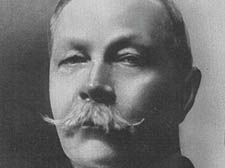|
|
 |
| |

Sir Arthur Conan Doyle |
The curious case of Arthur Conan Doyle
Sherlock Holmes may have been married to science, but his famous creator held an unshakeable belief in the supernatural, as Andrew Lycett tells to Dan Carrier
WHEN Sir Arthur Conan Doyle first set eyes on the American escape artist Harry Houdini, he knew he was in the presence of someone who was rather special.
But rather than admire Houdini for his sleight-of-hand and imaginative show, Conan Doyle, the man who created the world’s most rational problem-solver in Sherlock Holmes, believed there was something more to Houdini’s acts of on-stage bravado.
He befriended the showman and was disappointed to hear Houdini admit he was a cunning magician who held no real magic of his own. But Conan Doyle simply could not believe Houdini was not in possession of some kind of superhuman powers, and it led to a cooling in their friendship.
The intricacies of Conan Doyle, whose character Sherlock Holmes is still seen as the foremost detective in English literature well over a century after he first made his appearance, is the subject of a lecture on Monday by Primrose Hill-based biographer and historian Andrew Lycett.
Mr Lycett, due to speak at the Highgate Scientific and Literary Institute, says he has always been fascinated by the period which saw Conan Doyle become one of the pre-eminent story-tellers in the English language.
And Conan Doyle’s attraction is enduring – a new Sherlock Holmes film due out this year stars Robert Downey Jnr and Jude Law and is destined to be a major blockbuster. Mr Lycett says Conan Doyle and his creation is a reflection of the period – but shows how we still like the same heroes today.
“There was a subversive undercurrent coming to the fore back then,” he says. “If you look at Holmes himself he was a cocaine addict and very neurotic – in some ways he was very modern.”
Mr Lycett was first drawn to Conan Doyle as he completed his biographical work on Rudyard Kipling.
“I went to Kipling’s house in Vermont,” he recalls. “I heard he had been visited by Arthur Conan Doyle in 1894 for Thanksgiving. The pair played a game of golf in a field opposite his house and this really stuck in my imagination. I thought I’d turn my attentions to Conan Doyle.”
Conan Doyle was born to a Catholic family in Edinburgh but became agnostic in his early years. His father was an alcoholic and his mother domineering – it gave him the drive he needed to become a success. He trained as a doctor but despite this scientific background he was keen on spiritualism, the unknown and life after death.
“He wanted to answer questions about paranormal phenomenon. It fascinated him,” Mr Lycett says.
“He was an early promoter of scientific research into the paranormal. He just could not shake off this feeling that there was something more out there.”
Spiritualism won new followers during the slaughter of the First World War – with so many families having to contend with the grievious news of the loss of loved ones in the trenches, seances and mediums were popular. Grief-stricken lovers and parents of the dead young men littering the battlefields wanted the chance to say goodbye – and fraudulent cranks found their services in great demand.
Conan Doyle’s own descent into spiritualism dated from before the First World War, although Mr Lycett notes that Doyle also lost many people he was close to in the years 1914-18.
He had fallen into a tepid marriage with Louise Hawkins but soon fell for another. He kept his relationship with Jean Leckie platonic until after his first wife’s death from tuberculosis. It was another layer of guilt and tragedy for him to deal with. “He tried to maintain his scientific objectivity,” says Mr Lycett, “but there came a time in 1915 where there were family members dying and he decided he wanted something more – and decided to become a fully blown spiritualist.”
•
The adventures of Holmes in Camden and Islington
SIRir Arthur Conan Doyle knew the streets of Camden, Islington and Westminster well, despite making his home in Surrey and then Sussex.
He gave his detective a Regent’s Park address at 221b Baker Street, but he also featured Hampstead in his stories.
In one tale, The Worst Man in London, Holmes breaks into a Church Row mansion to foil a dastardly blackmailer, Charles Augustus Milverton. When he is disturbed, he is chased across the wilds of Hampstead Heath, finally avoiding his pursuer by going to ground in woods near Parliament Hill. |

|
 |
|
 |
|

